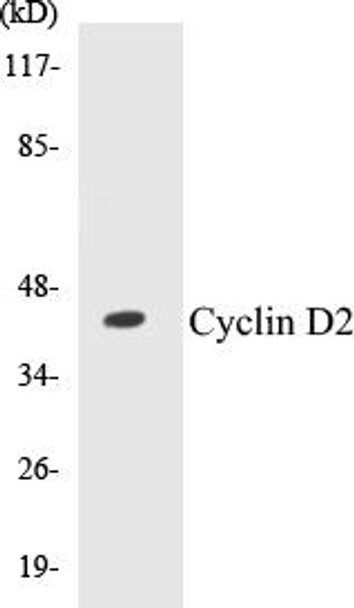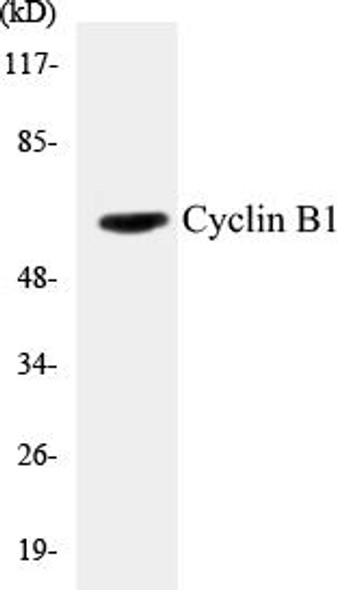Description
Cyclin D2 Colorimetric Cell-Based ELISA Kit
The Cyclin D2 Colorimetric Cell-Based ELISA Kit from Assay Genie is a comprehensive and reliable tool for measuring levels of Cyclin D2 in cell lysates and tissue samples. This kit offers high sensitivity and specificity, allowing researchers to obtain accurate and reproducible results for a variety of research applications.Cyclin D2 is a key regulator of cell cycle progression, playing a critical role in cell division and proliferation. Dysregulation of Cyclin D2 has been implicated in various diseases, including cancer, making it a valuable biomarker for studying disease mechanisms and potential therapeutic interventions.
This ELISA kit is easy to use, with a simple protocol that enables quick and efficient detection of Cyclin D2 levels. It is suitable for use in both academic research and clinical studies, providing valuable insights into the role of Cyclin D2 in health and disease. Upgrade your research with the Cyclin D2 Colorimetric Cell-Based ELISA Kit from Assay Genie.
| Product Name: | Cyclin D2 Colorimetric Cell-Based ELISA |
| Product Code: | CBCAB00611 |
| ELISA Type: | Cell-Based |
| Target: | Cyclin D2 |
| Reactivity: | Human, Mouse, Rat |
| Dynamic Range: | > 5000 Cells |
| Detection Method: | Colorimetric 450 nmStorage/Stability:4°C/6 Months |
| Format: | 96-Well Microplate |
The Cyclin D2 Colorimetric Cell-Based ELISA Kit is a convenient, lysate-free, high throughput and sensitive assay kit that can detect Cyclin D2 protein expression profile in cells. The kit can be used for measuring the relative amounts of Cyclin D2 in cultured cells as well as screening for the effects that various treatments, inhibitors (ie siRNA or chemicals), or activators have on Cyclin D2.
Qualitative determination of Cyclin D2 concentration is achieved by an indirect ELISA format. In essence, Cyclin D2 is captured by Cyclin D2-specific primary antibodies while the HRP-conjugated secondary antibodies bind the Fc region of the primary antibody. Through this binding, the HRP enzyme conjugated to the secondary antibody can catalyze a colorimetric reaction upon substrate addition. Due to the qualitative nature of the Cell-Based ELISA, multiple normalization methods are needed:
| 1. | A monoclonal antibody specific for human GAPDH is included to serve as an internal positive control in normalizing the target absorbance values. |
| 2. | Following the colorimetric measurement of HRP activity via substrate addition, the Crystal Violet whole-cell staining method may be used to determine cell density. After staining, the results can be analysed by normalizing the absorbance values to cell amounts, by which the plating difference can be adjusted. |
| Database Information: | Gene ID: 894, UniProt ID: P30279, OMIM: 123833, Unigene: Hs.376071 |
| Gene Symbol: | CCND2 |
| Sub Type: | None |
| UniProt Protein Function: | CCND2: Regulatory component of the cyclin D2-CDK4 (DC) complex that phosphorylates and inhibits members of the retinoblastoma (RB) protein family including RB1 and regulates the cell-cycle during G(1)/S transition. Phosphorylation of RB1 allows dissociation of the transcription factor E2F from the RB/E2F complex and the subsequent transcription of E2F target genes which are responsible for the progression through the G(1) phase. Hypophosphorylates RB1 in early G(1) phase. Cyclin D-CDK4 complexes are major integrators of various mitogenenic and antimitogenic signals. Also substrate for SMAD3, phosphorylating SMAD3 in a cell-cycle-dependent manner and repressing its transcriptional activity. Component of the ternary complex, cyclin D2/CDK4/p27Kip1, required for nuclear translocation and activity of the cyclin D-CDK4 complex. Interacts with either CDK4 or CDK6 protein kinase to form a serine/threonine kinase holoenzyme complex. The cyclin subunit imparts substrate specificity to the complex. Component of the ternary complex cyclin D/CDK4/p27Kip1 required for nuclear translocation and modulation of CDK4-mediated kinase activity. Belongs to the cyclin family. Cyclin D subfamily. |
| UniProt Protein Details: | Protein type:Motility/polarity/chemotaxis; Cell cycle regulation Chromosomal Location of Human Ortholog: 12p13 Cellular Component: chromatin; cyclin-dependent protein kinase holoenzyme complex; cytosol; nuclear membrane; nucleolus; nucleoplasm; nucleus Molecular Function:protein binding; protein kinase binding Biological Process: positive regulation of cyclin-dependent protein kinase activity; positive regulation of protein amino acid phosphorylation Disease: Megalencephaly-polymicrogyria-polydactyly-hydrocephalus Syndrome 3 |
| NCBI Summary: | The protein encoded by this gene belongs to the highly conserved cyclin family, whose members are characterized by a dramatic periodicity in protein abundance through the cell cycle. Cyclins function as regulators of CDK kinases. Different cyclins exhibit distinct expression and degradation patterns which contribute to the temporal coordination of each mitotic event. This cyclin forms a complex with CDK4 or CDK6 and functions as a regulatory subunit of the complex, whose activity is required for cell cycle G1/S transition. This protein has been shown to interact with and be involved in the phosphorylation of tumor suppressor protein Rb. Knockout studies of the homologous gene in mouse suggest the essential roles of this gene in ovarian granulosa and germ cell proliferation. High level expression of this gene was observed in ovarian and testicular tumors. Mutations in this gene are associated with megalencephaly-polymicrogyria-polydactyly-hydrocephalus syndrome 3 (MPPH3). [provided by RefSeq, Sep 2014] |
| UniProt Code: | P30279 |
| NCBI GenInfo Identifier: | 231741 |
| NCBI Gene ID: | 894 |
| NCBI Accession: | P30279.1 |
| UniProt Secondary Accession: | P30279,Q13955, Q5U035, A8K531, |
| UniProt Related Accession: | P30279 |
| Molecular Weight: | 24,461 Da |
| NCBI Full Name: | G1/S-specific cyclin-D2 |
| NCBI Synonym Full Names: | cyclin D2 |
| NCBI Official Symbol: | CCND2 |
| NCBI Official Synonym Symbols: | MPPH3; KIAK0002 |
| NCBI Protein Information: | G1/S-specific cyclin-D2 |
| UniProt Protein Name: | G1/S-specific cyclin-D2 |
| Protein Family: | G1/S-specific cyclin |
| UniProt Gene Name: | CCND2 |
| UniProt Entry Name: | CCND2_HUMAN |
| Component | Quantity |
| 96-Well Cell Culture Clear-Bottom Microplate | 2 plates |
| 10X TBS | 24 mL |
| Quenching Buffer | 24 mL |
| Blocking Buffer | 50 mL |
| 15X Wash Buffer | 50 mL |
| Primary Antibody Diluent | 12 mL |
| 100x Anti-Phospho Target Antibody | 60 µL |
| 100x Anti-Target Antibody | 60 µL |
| Anti-GAPDH Antibody | 60 µL |
| HRP-Conjugated Anti-Rabbit IgG Antibody | 12 mL |
| HRP-Conjugated Anti-Mouse IgG Antibody | 12 mL |
| SDS Solution | 12 mL |
| Stop Solution | 24 mL |
| Ready-to-Use Substrate | 12 mL |
| Crystal Violet Solution | 12 mL |
| Adhesive Plate Seals | 2 seals |
The following materials and/or equipment are NOT provided in this kit but are necessary to successfully conduct the experiment:
- Microplate reader able to measure absorbance at 450 nm and/or 595 nm for Crystal Violet Cell Staining (Optional)
- Micropipettes with capability of measuring volumes ranging from 1 µL to 1 ml
- 37% formaldehyde (Sigma Cat# F-8775) or formaldehyde from other sources
- Squirt bottle, manifold dispenser, multichannel pipette reservoir or automated microplate washer
- Graph paper or computer software capable of generating or displaying logarithmic functions
- Absorbent papers or vacuum aspirator
- Test tubes or microfuge tubes capable of storing ≥1 ml
- Poly-L-Lysine (Sigma Cat# P4832 for suspension cells)
- Orbital shaker (optional)
- Deionized or sterile water
*Note: Protocols are specific to each batch/lot. For the correct instructions please follow the protocol included in your kit.
| Step | Procedure |
| 1. | Seed 200 µL of 20,000 adherent cells in culture medium in each well of a 96-well plate. The plates included in the kit are sterile and treated for cell culture. For suspension cells and loosely attached cells, coat the plates with 100 µL of 10 µg/ml Poly-L-Lysine (not included) to each well of a 96-well plate for 30 minutes at 37°C prior to adding cells. |
| 2. | Incubate the cells for overnight at 37°C, 5% CO2. |
| 3. | Treat the cells as desired. |
| 4. | Remove the cell culture medium and rinse with 200 µL of 1x TBS, twice. |
| 5. | Fix the cells by incubating with 100 µL of Fixing Solution for 20 minutes at room temperature. The 4% formaldehyde is used for adherent cells and 8% formaldehyde is used for suspension cells and loosely attached cells. |
| 6. | Remove the Fixing Solution and wash the plate 3 times with 200 µL 1x Wash Buffer for five minutes each time with gentle shaking on the orbital shaker. The plate can be stored at 4°C for a week. |
| 7. | Add 100 µL of Quenching Buffer and incubate for 20 minutes at room temperature. |
| 8. | Wash the plate 3 times with 1x Wash Buffer for 5 minutes each time. |
| 9. | Add 200 µL of Blocking Buffer and incubate for 1 hour at room temperature. |
| 10. | Wash 3 times with 200 µL of 1x Wash Buffer for 5 minutes each time. |
| 11. | Add 50 µL of 1x primary antibodies (Anti-Cyclin D2 Antibody and/or Anti-GAPDH Antibody) to the corresponding wells, cover with Parafilm and incubate for 16 hours (overnight) at 4°C. If the target expression is known to be high, incubate for 2 hours at room temperature. |
| 12. | Wash 3 times with 200 µL of 1x Wash Buffer for 5 minutes each time. |
| 13. | Add 50 µL of 1x secondary antibodies (HRP-Conjugated AntiRabbit IgG Antibody or HRP-Conjugated Anti-Mouse IgG Antibody) to corresponding wells and incubate for 1.5 hours at room temperature. |
| 14. | Wash 3 times with 200 µL of 1x Wash Buffer for 5 minutes each time. |
| 15. | Add 50 µL of Ready-to-Use Substrate to each well and incubate for 30 minutes at room temperature in the dark. |
| 16. | Add 50 µL of Stop Solution to each well and read OD at 450 nm immediately using the microplate reader. |
(Additional Crystal Violet staining may be performed if desired – details of this may be found in the kit technical manual.)






